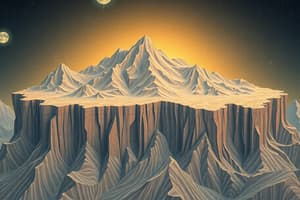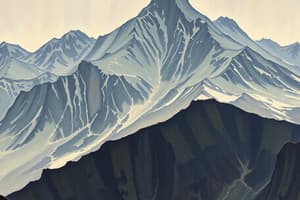Podcast
Questions and Answers
Which type of plate boundary is characterized by two plates sliding past one another?
Which type of plate boundary is characterized by two plates sliding past one another?
- Convergent boundary
- Transform boundary (correct)
- Divergent boundary
- Subduction boundary
What type of plate boundary is responsible for the formation of the Himalaya Mountains?
What type of plate boundary is responsible for the formation of the Himalaya Mountains?
- Divergent boundary
- Subduction boundary
- Convergent boundary (correct)
- Transform boundary
What type of plate boundary is characterized by two plates sliding apart from one another?
What type of plate boundary is characterized by two plates sliding apart from one another?
- Subduction boundary
- Convergent boundary
- Divergent boundary (correct)
- Transform boundary
What type of plate boundary is characterized by two plates sliding towards one another?
What type of plate boundary is characterized by two plates sliding towards one another?
What type of plate boundary is associated with the occurrence of deep, under-ocean trenches?
What type of plate boundary is associated with the occurrence of deep, under-ocean trenches?
Which type of plate boundary is associated with the San Andreas Fault in California?
Which type of plate boundary is associated with the San Andreas Fault in California?
What type of plate boundary caused the formation of Africa's Rift Valley?
What type of plate boundary caused the formation of Africa's Rift Valley?
What type of plate boundary can create mountains when two plates have roughly the same density?
What type of plate boundary can create mountains when two plates have roughly the same density?
Which type of plate boundary is associated with the 2004 Indian Ocean earthquake and tsunami?
Which type of plate boundary is associated with the 2004 Indian Ocean earthquake and tsunami?
What type of plate boundary is characterized by one plate sliding below another?
What type of plate boundary is characterized by one plate sliding below another?
Which type of plate boundary is characterized by two plates sliding past one another?
Which type of plate boundary is characterized by two plates sliding past one another?
What type of plate boundary is associated with the formation of the Himalaya Mountains?
What type of plate boundary is associated with the formation of the Himalaya Mountains?
What type of plate boundary can create mountains when two plates have roughly the same density?
What type of plate boundary can create mountains when two plates have roughly the same density?
Which type of plate boundary is associated with the occurrence of deep, under-ocean trenches?
Which type of plate boundary is associated with the occurrence of deep, under-ocean trenches?
What type of plate boundary caused the formation of Africa's Rift Valley?
What type of plate boundary caused the formation of Africa's Rift Valley?
Flashcards
Transform boundary
Transform boundary
A type of plate boundary where two tectonic plates slide horizontally past each other.
Convergent boundary
Convergent boundary
A type of plate boundary where two plates collide, resulting in the formation of mountains.
Divergent boundary
Divergent boundary
A type of plate boundary where two plates move apart from each other.
Subduction boundary
Subduction boundary
Signup and view all the flashcards
Transform fault
Transform fault
Signup and view all the flashcards
Trench
Trench
Signup and view all the flashcards
Continental-continental collision
Continental-continental collision
Signup and view all the flashcards
Rift valley
Rift valley
Signup and view all the flashcards
Earthquake zone
Earthquake zone
Signup and view all the flashcards
Tsunami
Tsunami
Signup and view all the flashcards
Seafloor spreading
Seafloor spreading
Signup and view all the flashcards
Oceanic-oceanic convergence
Oceanic-oceanic convergence
Signup and view all the flashcards
Oceanic-continental convergence
Oceanic-continental convergence
Signup and view all the flashcards
Mantle
Mantle
Signup and view all the flashcards
Strike-slip fault
Strike-slip fault
Signup and view all the flashcards




